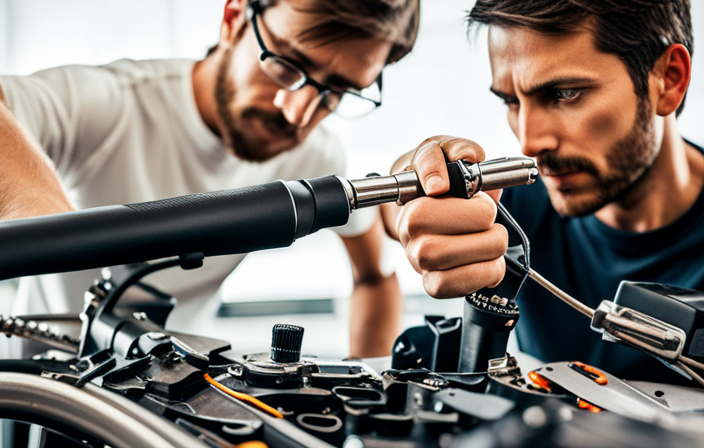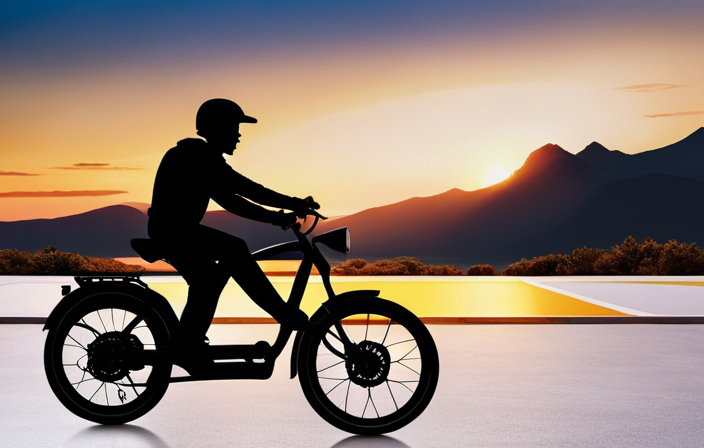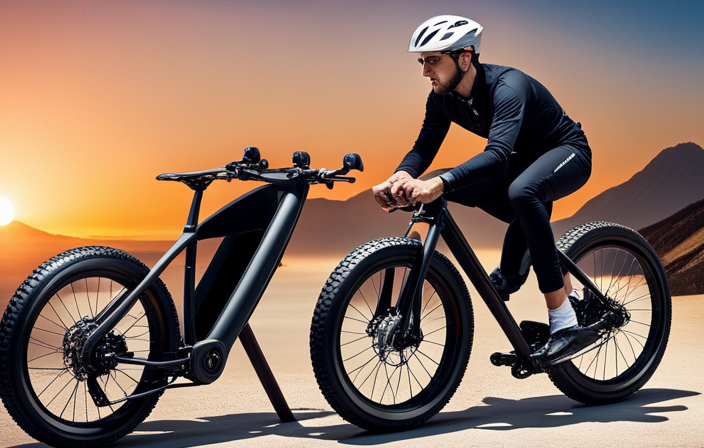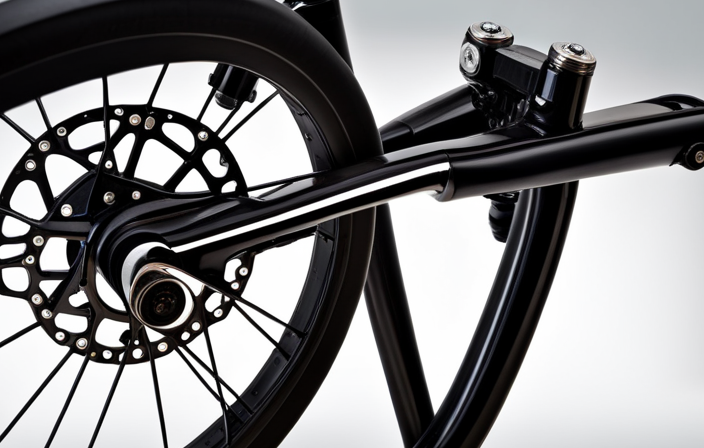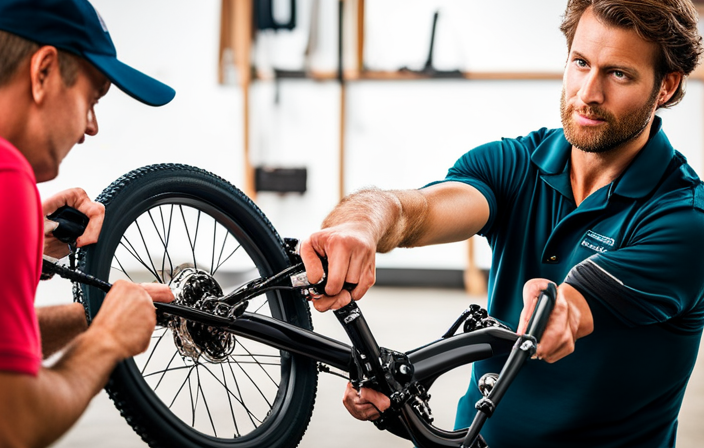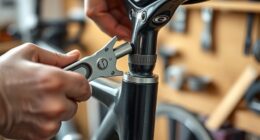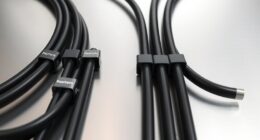Similar to how a steering wheel is crucial for a car, a throttle is vital for an electric bike, as it regulates speed and acceleration. If this important part fails, don’t worry, I have a solution for you.
In this article, I will guide you through the troubleshooting process, providing technical and detailed steps to fix your electric bike throttle. From checking for loose connections to considering an upgrade, you’ll find all the answers you need to get back on the road in no time.
Key Takeaways
- Calibrating the throttle can solve performance issues and ensure optimal functionality.
- Checking for software updates can improve the performance of the throttle.
- Consulting the user manual provides troubleshooting techniques and instructions for fixing issues.
- Seeking professional assistance is recommended for complex throttle problems, while online forums can provide additional advice.
Check for Loose Connections
You should check if there are any loose connections in your electric bike throttle. Proper throttle installation is crucial for ensuring smooth and efficient operation of your electric bike.
Loose connections can lead to a variety of issues with the throttle, causing it to malfunction or not respond properly. Common issues with electric bike throttles include intermittent power delivery, inconsistent speed control, and unresponsive throttle response.
To check for loose connections, start by disconnecting the throttle from the controller. Inspect the wires and connectors for any signs of damage or looseness. Ensure that all connections are securely plugged in and tightened. If you find any loose connections, reattach them properly.
Once you have addressed any loose connections, you can proceed to the next step of cleaning the throttle, which is essential for maintaining its performance.
Clean the Throttle
To clean the throttle on an electric bike, start by gently wiping it with a damp cloth. Ensure that the cloth is not dripping wet, as excess moisture can damage the electrical components.
Next, use a small brush or toothbrush to remove any dirt or debris that may be stuck in the crevices of the throttle. Be careful not to press too hard or use any sharp objects that could cause damage.
To replace the throttle cable, first, locate the cable where it connects to the throttle housing. Use pliers to loosen the cable clamp and disconnect the old cable. Then, insert the new cable into the throttle housing and tighten the clamp securely.
If you are experiencing issues with throttle response, troubleshoot by checking the wiring connections. Inspect the wiring for any loose or disconnected connections, and ensure that all wires are securely connected. This will help ensure proper communication between the throttle and the electric bike’s motor.
Inspect the Wiring
Inspecting the wiring is essential to ensure proper communication between the throttle and the electric bike’s motor.
To begin, carefully examine the wires for any signs of damage, such as fraying or exposed sections. Damaged wires can interfere with the throttle’s functionality and should be repaired or replaced as necessary.
Additionally, check the connection points between the wires and the throttle and motor to ensure they are secure and free from corrosion.
Once the wiring has been inspected and any issues have been addressed, it is crucial to test the throttle resistance. This can be done by gently manipulating the throttle and observing the response from the motor. If the throttle feels sticky or unresponsive, it may need to be cleaned or calibrated.
By thoroughly inspecting the wiring and testing the throttle resistance, you can identify and resolve any issues that may be affecting your electric bike’s performance.
Next, let’s move on to testing the battery.
Test the Battery
After inspecting the wiring, it’s important to test the battery to ensure optimal performance of the electric bike. To test the battery, follow these steps:
-
Check the battery life: Connect the battery to a voltmeter to measure its voltage. A fully charged battery should read around 36-42 volts. If the voltage is significantly lower, it may indicate a weak battery that needs replacement.
-
Check charger compatibility: Verify that the charger you’re using is compatible with your electric bike’s battery. Using an incompatible charger can lead to improper charging and potential damage to the battery.
-
Monitor charging process: Connect the charger to the battery and observe the charging process. Ensure that the battery is charging properly and reaching its full capacity.
Testing the battery and ensuring proper charging is crucial for identifying any issues related to power supply. This will help determine if the problem lies with the battery or other faulty components.
Replace Faulty Components
Now it’s time to replace any faulty components on your electric bike. One of the main reasons for throttle issues is damaged components such as the throttle cable, throttle grip, or throttle body. To troubleshoot throttle issues, start by inspecting the throttle cable for any fraying, kinks, or breakage. If it is damaged, it needs to be replaced with a new one. Next, check the throttle grip for any signs of wear or damage. If it is worn out, it should be replaced as well. Lastly, examine the throttle body for any dirt or debris that may be affecting its performance. Clean it thoroughly or replace it if necessary. Remember to refer to the user manual for specific instructions on how to replace these components. Once you have replaced the faulty components, you can proceed to adjust the throttle tension in the next section.
Adjust the Throttle Tension
To properly adjust the throttle tension, start by loosening the throttle cable locknut. This will allow you to make adjustments to the cable tension. Once the locknut is loose, you can turn the throttle cable adjustment screw clockwise to increase tension or counterclockwise to decrease tension. Adjust the tension until the throttle response feels comfortable and responsive.
If the throttle is too sensitive, causing sudden acceleration or jerky movements, you can decrease the tension slightly. On the other hand, if the throttle is unresponsive or sluggish, you can increase the tension. It may take some trial and error to find the right balance for your electric bike.
Once you have adjusted the throttle sensitivity, you can move on to the next step of troubleshooting: lubricating the moving parts for smoother operation.
Lubricate Moving Parts
To ensure smooth operation, it is crucial to properly lubricate the moving parts of your electric bike. This is important because lubrication reduces friction and wear, allowing the throttle to function optimally.
One common mistake to avoid is using the wrong type of lubricant. It is essential to use a lubricant specifically designed for bike parts to prevent damage. Apply the lubricant to the pivot points and joints of the throttle, ensuring thorough coverage. Be careful not to over-lubricate, as excess lubricant can attract dirt and debris, leading to clogs and potential malfunctions.
Regularly inspect the throttle and reapply lubricant as needed. By maintaining proper lubrication, you can extend the lifespan of your electric bike’s throttle and prevent unnecessary repairs.
Now, let’s move on to the next section and learn how to reset the controller.
Reset the Controller
Resetting the controller can help resolve any issues you may be experiencing with your electric bike’s throttle. When the throttle is not working properly, it could be due to a glitch or error in the controller.
To reset the controller, locate the reset button on the controller box and press it for a few seconds. This will restore the default settings and clear any temporary faults.
After resetting the controller, test the throttle to see if it is functioning correctly. If the problem persists, there may be other underlying issues with the throttle that require further troubleshooting.
In the next section, we will discuss how to calibrate the throttle for optimal performance.
Calibrate the Throttle
Calibrating the throttle ensures optimal performance of your electric bike. It allows you to adjust the throttle sensitivity, ensuring a smooth and responsive ride. To troubleshoot throttle response issues, calibrating the throttle is often recommended as a first step.
Start by locating the throttle adjustment screw on your electric bike. This screw is usually found on the handlebar near the throttle itself. Use a screwdriver to make small adjustments, testing the throttle response after each adjustment. Turn the screw clockwise to increase sensitivity and counterclockwise to decrease sensitivity.
If calibrating the throttle does not solve the issue, it may be necessary to check for software updates. This step can help address any underlying software issues that may be affecting the throttle’s performance.
Check for Software Updates
Checking for software updates can help address any underlying issues that may be affecting the performance of your electric bike’s throttle. To ensure firmware compatibility and troubleshoot common software issues, follow these steps:
- Connect your electric bike to a computer or smartphone using the provided USB cable.
- Visit the manufacturer’s website or app to check for any available software updates specifically for your bike model.
- Download and install the latest firmware update onto your bike’s throttle system.
- After the update is complete, restart your electric bike and test the throttle to see if the issues have been resolved.
By regularly checking for software updates, you can ensure that your electric bike’s throttle is running on the latest version of its software, minimizing compatibility issues and maximizing performance.
For further troubleshooting steps, consult the user manual for your specific electric bike model.
Consult the User Manual
After checking for software updates, the next step in troubleshooting your electric bike throttle is to consult the user manual. The user manual contains important information about the specific model of your bike, including troubleshooting techniques and common throttle issues. It provides detailed instructions on how to identify and fix any problems you may be experiencing with the throttle.
To help you better understand the troubleshooting process, here is a table that highlights the most common throttle issues and their possible causes:
| Throttle Issue | Possible Cause |
|---|---|
| Throttle not working | Loose connection |
| Inconsistent speed | Dirty throttle contacts |
| Delayed response | Faulty throttle sensor |
| Stuck throttle | Broken throttle mechanism |
By referring to the user manual and using this table as a guide, you can effectively troubleshoot and resolve most throttle issues on your own. However, if you are unable to fix the problem, it may be necessary to seek professional assistance.
Seek Professional Assistance
If you’re unable to resolve the issue, it might be best to consult a professional for assistance. Seeking professional advice is a wise decision when dealing with complex electric bike throttle problems.
Professionals have the expertise and experience to diagnose and fix the issue accurately. They can also provide guidance on potential troubleshooting steps you can take in the future.
Additionally, online forums dedicated to electric bikes can be a valuable resource for troubleshooting. Many enthusiasts and experts are active in these forums and can offer advice based on their own experiences. However, it’s important to exercise caution and verify the information provided by online sources.
In the next section about troubleshooting error codes, we will explore common error codes and how to address them effectively.
Troubleshoot Error Codes
One way to address error codes on your electric bike is by consulting a professional for guidance. However, if you prefer troubleshooting the issue yourself, there are some techniques you can try.
When encountering error codes, it is essential to refer to your bike’s manual to understand the specific meaning behind each code. Common error messages include ‘Error 1: Throttle Signal Abnormal’ or ‘Error 2: Throttle Voltage Out of Range.’
To troubleshoot these errors, you can start by checking the throttle connection, ensuring it is securely attached to the controller. You can also inspect the throttle cable for any signs of damage or wear. Additionally, resetting the controller or updating its firmware might resolve certain error codes.
If these troubleshooting techniques fail to fix the problem, you may want to consider upgrading to a new throttle, which we will discuss in the next section.
Consider Upgrading to a New Throttle
After troubleshooting the error codes on my electric bike throttle, I’ve come to the conclusion that it may be time to consider upgrading to a new throttle.
While repairing the current throttle is an option, exploring alternative throttle options can provide a more reliable and efficient solution.
Upgrading to a new throttle can offer improved performance and functionality, ensuring a smoother riding experience.
When considering a new throttle, it’s essential to look for features such as a responsive and ergonomic design, compatibility with your electric bike model, and easy installation. Additionally, it’s worth exploring throttle options that offer customizable settings, allowing you to adjust the sensitivity and responsiveness to suit your riding preferences.
By upgrading to a new throttle, you can enhance your electric bike’s performance and enjoy a more enjoyable ride. However, before making any changes, it’s crucial to maintain regular maintenance and inspections to ensure the longevity of your electric bike.
Maintain Regular Maintenance and Inspections
To ensure the longevity of your electric bike, it’s important to regularly maintain and inspect it. Neglecting maintenance can lead to reduced performance and potential issues with the throttle. Electric bike throttles are prone to wear and tear due to constant use and exposure to the elements. Regular maintenance can help identify and address any emerging problems before they escalate.
Here is a table to illustrate the importance of regular maintenance for electric bike performance:
| Issue | Solution | Emotional Response |
|---|---|---|
| Sticky throttle | Clean and lubricate the throttle | Smooth and effortless riding experience |
| Inconsistent speed | Check and adjust throttle settings | Consistent and reliable performance |
| Unresponsive | Replace throttle or check connections | Confidence in bike’s responsiveness |
By maintaining your electric bike and addressing any throttle issues promptly, you can ensure optimal performance and a more enjoyable riding experience.
Frequently Asked Questions
Can I fix my electric bike throttle if it is not mentioned in the article sections?
I cannot fix my electric bike throttle if it is not mentioned in the article sections. However, if I encounter common throttle issues, I can use troubleshooting techniques to identify and potentially resolve the problem.
How can I troubleshoot error codes on my electric bike throttle?
To troubleshoot error codes on an electric bike throttle, I recommend using techniques like checking the wiring connections, inspecting for physical damage, and resetting the throttle. Common error codes may include E01 for throttle signal error or E03 for throttle voltage error.
Should I consider upgrading to a new throttle if I cannot fix the existing one?
If I am unable to fix my existing electric bike throttle, I should consider upgrading to a new one. There are various upgrading options available, and troubleshooting techniques may help determine if a new throttle is necessary.
What should I do to maintain regular maintenance and inspections for my electric bike throttle?
To maintain my electric bike throttle, I regularly inspect the wiring for any signs of damage or loose connections. I also clean the throttle with a mild detergent and ensure it is properly lubricated. Common issues include faulty wiring and worn-out components.
Is there any specific way to reset the controller of my electric bike throttle?
To reset the controller of your electric bike throttle, try these troubleshooting techniques. First, disconnect the throttle from the controller. Then, press and hold the reset button on the controller for a few seconds. Reconnect the throttle and test if the reset resolved the issue.
Conclusion
So there you have it, folks. By following these steps, you can easily fix your electric bike throttle and get back on the road in no time.
Don’t let a malfunctioning throttle bring you down – take charge and tackle the issue head-on. With a little perseverance and some basic troubleshooting skills, you’ll be zooming along on your electric bike once again.
Remember, maintaining regular maintenance and inspections is key to avoiding future problems.
So go out there and conquer the road with your newly repaired electric bike throttle!
